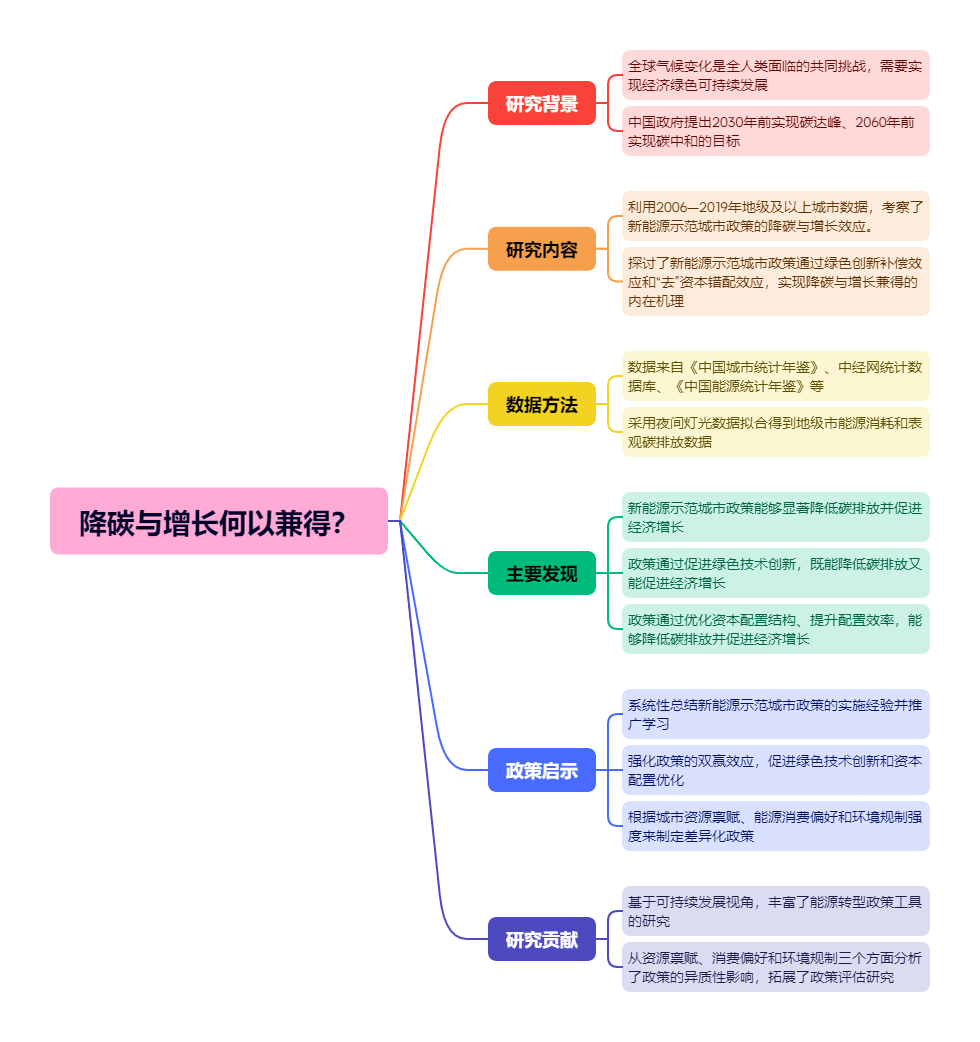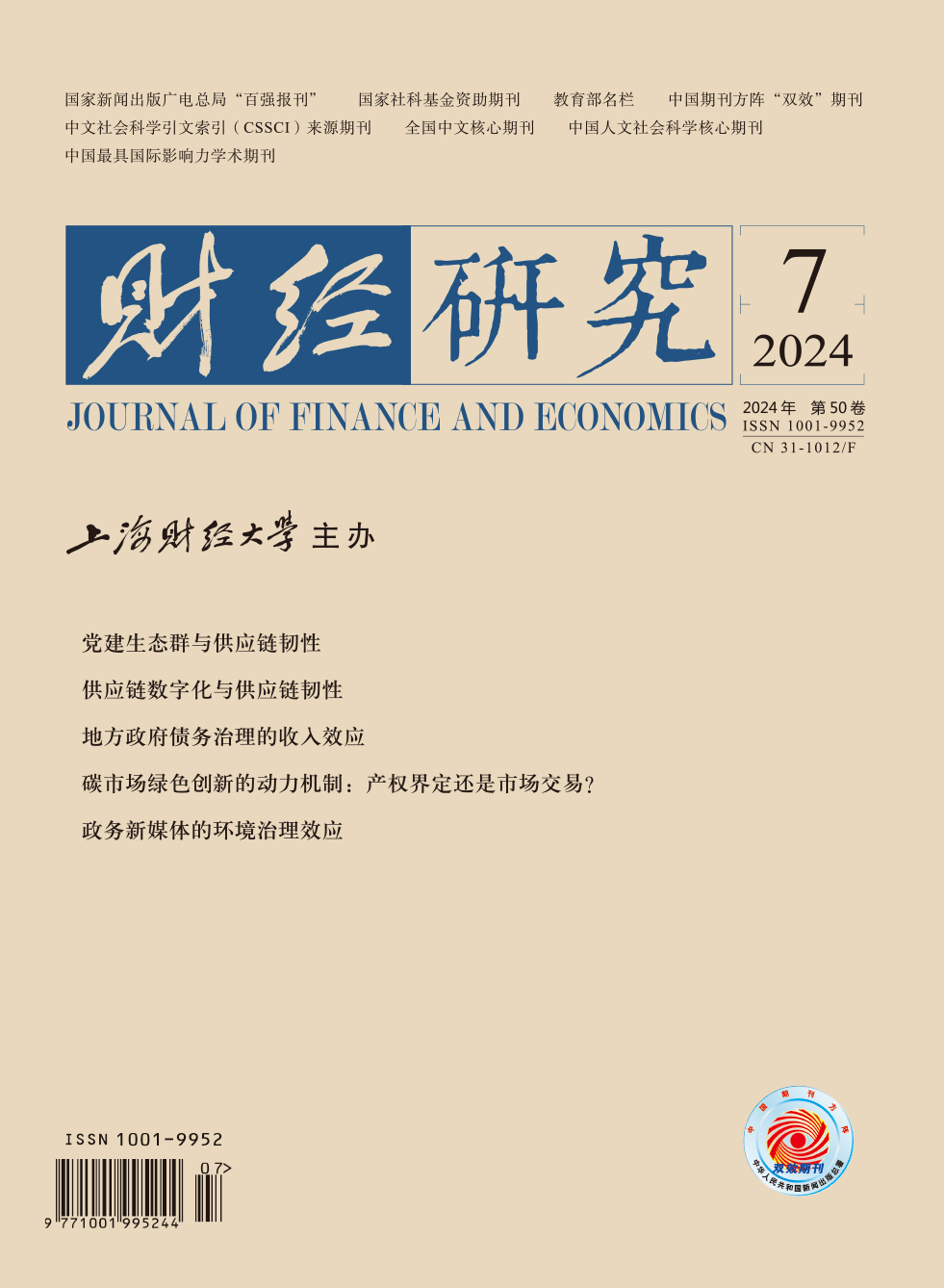实现经济绿色可持续发展需要将经济增长纳入气候变化的约束框架。文章基于可持续发展视角下两难困境的现实问题,将降碳与增长纳入统一框架,通过绿色创新补偿效应与“去”资本错配效应阐明新能源示范城市政策实现降碳与增长兼得的逻辑过程。文章构建双重差分模型,并利用2006—2019年地级及以上城市数据进行实证检验。研究发现,新能源示范城市政策能显著降低碳排放并促进经济增长,实现降碳与增长兼得。机制分析表明,绿色创新补偿效应不仅发挥了绿色技术进步的减碳作用,而且创新补偿效应能够助推城市经济增长。“去”资本过度配置能优化资本配置结构、提升配置效率,进而降低碳排放并促进经济增长。异质性分析表明,由于城市资源禀赋特征、能源消费偏好及环境规制强度不同,新能源示范城市政策的“破局”效应存在明显差异。文章结论为新能源示范城市政策突破两难困境提供了可靠的经验证据,同时有助于加深对能源转型政策的理解,为实现“双碳”目标与持续推进生态文明建设提供有益借鉴。
降碳与增长何以兼得?——基于新能源示范城市政策的经验研究
摘要
参考文献
相关附件
思维导图
5 江艇. 因果推断经验研究中的中介效应与调节效应[J]. 中国工业经济,2022,(5):100−120. DOI:10.3969/j.issn.1006-480X.2022.05.007
9 李豫新,程洪飞,倪超军. 能源转型政策与城市绿色创新活力——基于新能源示范城市政策的准自然实验[J]. 中国人口•资源与环境,2023,(1):137−149.
14 娄伟. 基于“6A”理念的新能源城市规划方法研究[J]. 华中科技大学学报(社会科学版),2014,(2):54−59. DOI:10.3969/j.issn.1671-7023.2014.02.010
16 史丹,李少林. 排污权交易制度与能源利用效率——对地级及以上城市的测度与实证[J]. 中国工业经济,2020,(9):5−23. DOI:10.3969/j.issn.1006-480X.2020.09.001
25 庄贵阳. 中国低碳城市试点的政策设计逻辑[J]. 中国人口•资源与环境,2020,(3):19−28.
26 Acemoglu D,Aghion P,Bursztyn L,et al. The environment and directed technical change[J]. American Economic Review,2012,102(1):131−166. DOI:10.1257/aer.102.1.131
27 Borghesi S,Cainelli G,Mazzanti M. Linking emission trading to environmental innovation:Evidence from the Italian manufacturing industry[J]. Research Policy,2015,44(3):669−683. DOI:10.1016/j.respol.2014.10.014
28 Chakraborty P,Chatterjee C. Does environmental regulation indirectly induce upstream innovation? New evidence from India[J]. Research Policy,2017,46(5):939−955. DOI:10.1016/j.respol.2017.03.004
29 Chang C H. The influence of corporate environmental ethics on competitive advantage:The mediation role of green innovation[J]. Journal of Business Ethics,2011,104(3):361−370. DOI:10.1007/s10551-011-0914-x
30 Deschênes O,Greenstone M,Shapiro J S. Defensive investments and the demand for air quality:Evidence from the NOx budget program[J]. American Economic Review,2017,107(10):2958−2989. DOI:10.1257/aer.20131002
31 Destek M A,Aslan A. Disaggregated renewable energy consumption and environmental pollution nexus in G-7 countries[J]. Renewable Energy,2020,151:1298−1306. DOI:10.1016/j.renene.2019.11.138
32 El-Kassar A N,Singh S K. Green innovation and organizational performance:The influence of big data and the moderating role of management commitment and HR practices[J]. Technological Forecasting and Social Change,2019,144:483−498. DOI:10.1016/j.techfore.2017.12.016
33 Harris D,Skeels C L. Mostly harmless econometrics:An empiricist’s companion[J]. Economic Record,2011,87(277):350−352. DOI:10.1111/j.1475-4932.2011.00742.x
34 Lin B Q,Zhu J P. The role of renewable energy technological innovation on climate change:Empirical evidence from China[J]. Science of the Total Environment,2019,659:1505−1512. DOI:10.1016/j.scitotenv.2018.12.449
35 Milani S. The impact of environmental policy stringency on industrial R&D conditional on pollution intensity and relocation costs[J]. Environmental and Resource Economics,2017,68(3):595−620. DOI:10.1007/s10640-016-0034-2
36 Porter M E,van der Linde C. Toward a new conception of the environment-competitiveness relationship[J]. Journal of Economic Perspectives,1995,9(4):97−118. DOI:10.1257/jep.9.4.97
37 Sadikoglu E,Zehir C. Investigating the effects of innovation and employee performance on the relationship between total quality management practices and firm performance:An empirical study of Turkish firms[J]. International Journal of Production Economics,2010,127(1):13−26. DOI:10.1016/j.ijpe.2010.02.013
38 Wang F J,Sun J Q,Liu Y S. Institutional pressure,ultimate ownership,and corporate carbon reduction engagement:Evidence from China[J]. Journal of Business Research,2019,104:14−26. DOI:10.1016/j.jbusres.2019.07.003
39 Wang Q,Yi H T. New energy demonstration program and China's urban green economic growth:Do regional characteristics make a difference?[J]. Energy Policy,2021,151:112161. DOI:10.1016/j.enpol.2021.112161
40 Wang S H,Wang X Q,Lu B B. Is resource abundance a curse for green economic growth? Evidence from developing countries[J]. Resources Policy,2022,75:102533. DOI:10.1016/j.resourpol.2021.102533
41 Wu J,Zuidema C,Gugerell K,et al. Mind the gap! Barriers and implementation deficiencies of energy policies at the local scale in urban China[J]. Energy Policy,2017,106:201−211. DOI:10.1016/j.enpol.2017.03.057
42 Wu W L,Cheng Y Y,Lin X Q,et al. How does the implementation of the policy of electricity substitution influence green economic growth in China?[J]. Energy Policy,2019,131:251−261. DOI:10.1016/j.enpol.2019.04.043
43 Yang C H,Tseng Y H,Chen C P. Environmental regulations,induced R&D,and productivity:Evidence from Taiwan's manufacturing industries[J]. Resource and Energy Economics,2012,34(4):514−532. DOI:10.1016/j.reseneeco.2012.05.001
44 Yang X D,Zhang J N,Ren S Y,et al. Can the new energy demonstration city policy reduce environmental pollution? Evidence from a quasi-natural experiment in China[J]. Journal of Cleaner Production,2021,287:125015. DOI:10.1016/j.jclepro.2020.125015
45 Zhang W,Li J,Li G X,et al. Emission reduction effect and carbon market efficiency of carbon emissions trading policy in China[J]. Energy,2020,196:117117. DOI:10.1016/j.energy.2020.117117
46 Zhu J M,Fan Y C,Deng X H,et al. Low-carbon innovation induced by emissions trading in China[J]. Nature Communications,2019,10(1):4088. DOI:10.1038/s41467-019-12213-6
引用本文
程洪飞, 李豫新, 曹梦渊. 降碳与增长何以兼得?——基于新能源示范城市政策的经验研究[J]. 财经研究, 2024, 50(7): 126-140.
导出参考文献,格式为:





 4848
4848  5414
5414


